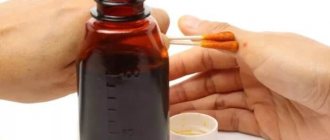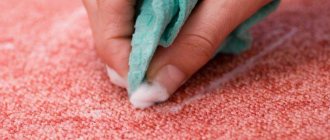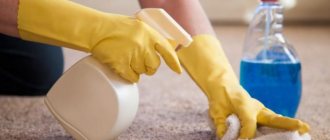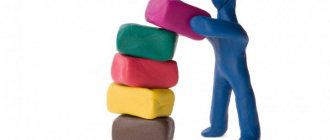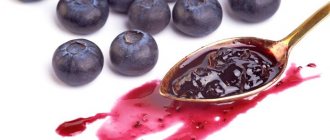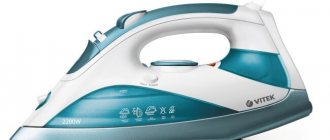The plastic pieces contain wax, paraffin, dyes and fats. It’s not difficult to get rid of a colored stain; the main problem is a greasy stain that will make mom work hard.
In this article we will tell you how and with what you can remove plasticine from wallpaper, carpet, table, skin and hair, and toys.
How to remove a fresh stain?
Before the plasticine has time to melt and penetrate deep into the surface structure, it must be removed. The primary task is to get rid of the colored cake in any way possible. It can be heated to gently peel it off using paper, or frozen.
You should not try to scrub the stain, this will worsen the problem and increase the area of contamination.
The next stage is to eliminate the greasy trace from the plastic mass. Here you can use any product from the housewife’s arsenal:
- soda;
- ammonia;
- laundry soap;
- dishwashing liquid;
- stain remover
You need to choose a method for cleaning the surface taking into account the material from which the item is made.
Grandmother's method
Suitable for all types of fabric, except thin ones. It consists of wiping away the oil trace with a natural wool sock. The result depends on the quality of the wool and the hard work of the owner.
Purchased household stain removers remain a win-win option, if there are no restrictions on the use of chemicals, the price suits you.
Temperature effect
Modeling mass has an interesting physical property - it changes structure under the influence of temperature. In the cold, plasticine loses its plasticity and becomes hard. Its melting point is low, so when it comes into contact with hands, heating devices and warm air, it practically “floats”. This property can be used by the hostess.
First method (cold):
- Place the product in the freezer.
- Wait until the mixture hardens (no more than 20 minutes).
- Tear off the cake using tweezers.
It is not recommended to separate the plasticine with your hands; it may melt again. If the surface is large, for example, a carpet, you can use ice cubes for freezing.
Second method (hot):
- Spread the product on a flat surface.
- Cover the stain with a thick sheet of paper.
- Iron with a heated iron until the mass sticks to the sheet.
Both methods involve subsequent washing to remove the greasy mark from the plasticine cake and treating the affected area with special products.
What not to do?
In order not to complicate your work when removing plasticine, follow these recommendations:
- If you find an adhering mass, do not rub it, spreading it even more over the surface;
- When removing plasticine with a chemical agent, make sure that the surface will not be damaged; you can first test it on a small area:
- Before you start cleansing with products, remove the main lump;
- Do not remove the sticky mass from your hair without using the product.
Folk recipes
If plasticine gets on the surface, you need to act quickly. If you don’t have special tools at hand, you can use the improvised ones that can be found in every home .
Laundry soap
An effective method to solve the problem on textile surfaces. It is necessary to use soap with a fatty acid content of 72%.
Algorithm of actions:
- soak the soiled item for 15 minutes in warm water;
- treat the area with plasticine with laundry soap;
- leave for 30 minutes;
- clean off the plastic mass with a brush;
- wash the product as usual.
If the stain is not completely gone, add a little baking soda and rub.
Ammonia
You can fight pigment residues and greasy stains with ammonia.
Step-by-step instruction:
- Prepare a solution of 200 ml of water and 10 drops of ammonia.
- Soak a cotton swab in the liquid.
- Treat the contaminated area.
- Rinse the product in cool water.
The method is not suitable for delicate fabrics.
Sunflower oil
A component that the housewife always has at hand. The product can be used on plastic and rubber surfaces.
Instructions for use on fabrics:
- soak the swab in oil;
- process the plasticine cake with it;
- rub the dirt with your hands so that the sticky mass rolls off;
- Carefully remove the pellets.
The main disadvantage of the method is the need to remove the greasy stain after treatment.
The effect of sunflower oil on stuck plasticine - in the video:
Cotton clothing
Quite often you have to deal with plasticine stains on cotton clothes. Children do modeling indoors: at home, in kindergarten, school, and creative clubs.
- Parents try to dress their child in things made from natural fabrics.
- Light and soft cotton is preferred.
- When cleaning cotton fabrics, you should treat colored items with care so that they do not fade or lose the brightness of their colors.
Industrial products
Household chemicals that will help cope with the problem can be divided into 4 groups:
- Bleaches, stain removers, washing liquids - work well on textile surfaces.
- Solvents with an aggressive composition are used in extreme cases.
- Car care products – effective on large plastic areas.
- Cooling agents are universal “saviors”.
When choosing household chemicals, you should avoid aggressive components, since their areas of application are often children's clothing and toys. Popular with housewives:
Vanish Oxi Action Stain Remover
Liquid concentrate for different types of fabrics does not contain chlorine and copes with all types of stains , including old ones. Removes pigment residues and greasy stains after contact of fabric with plasticine. Price for 1 liter – 400 rubles. Read reviews here, here and here.
Freezing spray for chewing gum Axel-9 Anti-gum
Fights the sticky mass of chewing gum and plasticine on any surface. Just spray it and remove the dirt. Must be stored out of the reach of children. The price for a 0.3 l cylinder is 700 rubles.
Frau Schmidt universal liquid soap
The product, without phosphates and chlorine, is designed to remove stubborn stains from textile surfaces. Does not cause allergic reactions. Price for 500 ml 300 rubles. Read reviews here.
Linen products
Clothing made from linen fabrics is in demand, it is practical, does not cause allergies, and lasts longer than cotton. Children's clothes made of linen have firmly taken their place in the children's wardrobe.
Plasticine stains on light linen shorts and shirts can be easily removed using an aqueous solution of ammonia (a tablespoon of alcohol per 100 ml of water), which is rubbed with a cotton pad into the stained area.
Features of cleaning various surfaces
Each material requires an individual approach to combat adhering mass. Sometimes, to achieve a goal, you have to use more than one recipe, but combine several.
Fabric and clothing
To remove plasticine from a textile surface, you can use the physical properties of the creative material, that is, heat or freeze. An alternative option is to use a budget method proven by housewives:
- Grind a piece of laundry soap on a grater.
- Add hydrogen peroxide to the shavings until a paste forms.
- Apply the product to the contaminated area.
- Clean the plasticine with a toothbrush.
- Wash the item.
The method is suitable for cleaning clothes, upholstery and tablecloths. Before processing curtains and drapes, they must be removed.
Table
The cake can be scraped off from flat and hard surfaces (shelves, tables, armrests, cabinets) . You need to act carefully so as not to damage the top layer, otherwise the next step will be removing scratches from the furniture.
It is better to use plastic modeling tools, which are sold together with plasticine. After removing the pigment, the table must be washed with soap or saline solution.
Carpet
It is very difficult to scrape off a stuck cake from the pile surface; most likely, the plasticine will remain in place, and the size of the stain will increase.
If the method turns out to be effective, a cloth soaked in purified kerosene will help .
It’s easier to take advantage of the physical properties of the colored mass - freeze it with an ice cube or melt it with a hairdryer and transfer it to a thick sheet of paper. Any greasy stain left on the carpet can be removed using dishwashing liquid (such as Fairy). The method is suitable for cleaning fabric upholstery.
How to remove plasticine from a carpet, read this article.
Wallpaper
The algorithm of actions resembles the process of removing colored cakes from fabric . But there are subtleties. If the walls are covered with paper wallpaper, you cannot use ammonia, soda or kerosene. This will completely ruin the appearance of the coating.
It is also difficult to remove plasticine from embossed wallpaper. To do this, use a thin needle, then wash the surface with a brush dipped in a soap solution.
You can try to peel off the sticky mass with the same material. A small piece will help remove plasticine from the wallpaper. This publication will tell you more about removing plasticine from wallpaper.
Plastic
Plastic also reacts to temperature changes. In the cold it becomes brittle, and contact with heat causes it to melt. A safe way to remove sticky stuff from plastic toys or PVC furniture:
- apply vegetable oil to a cloth;
- treat the problem area;
- remove excess fat with soap solution;
- Wipe the surface with a cloth soaked in clean water.
The product is not suitable for cleaning soft toys. Freezing and washing will help textiles.
Tips for cleaning toys from plasticine - in the video:
Hair
It is not worth experimenting on hair with aggressive components.
A safe, but time-consuming way to rid your hair of plasticine is sunflower oil. It is necessary to wet your hands in it, begin to separate the stuck mass and untangle the strands.
After the procedure, you should thoroughly wash your hair several times to get rid of stickiness and oily shine.
Leather
The sculptor’s hands are the first to suffer during sculpting. To put them in order, it is necessary to assess the scale of the problem:
light contamination can be removed by washing with warm water and baby soap;- a strong soap-scrub with a natural composition will help remove;
- the plasticine under the nails will disappear after a fifteen-minute bath with soapy water.
If no method gives 100% results, you need to use oil. Any will do: baby for the body, sunflower, olive, and so on. A simple and pleasant way for a child to get rid of multi-colored marks is to take a bath.
How to wash plasticine from plastic?
During modeling, it is easy to stain plastic toys or a plastic work surface. Clean the plasticine off the table with a knife or scraper. If the surface is smooth and flat, you will be able to remove most of the plasticine and remove the remaining greasy trace with a cotton swab dipped in ammonia. It is not recommended to wipe the table with a damp cloth; the substance will become even more sticky.
You can wash plasticine from small toys by immersing them in hot water and then removing any remaining dirt with paper napkins. The softened substance will be easier to remove without leaving a trace. Large toys can be heated with a hairdryer.
Advice! The same methods can be used to clean plastic construction sets.
To get rid of greasy marks from plastic, 3% hydrogen peroxide and a weak solution of dishwashing liquid are also suitable.
To tidy up soft toys or dolls, it is recommended to use the freezing method.
Tips for parents
You can avoid problems with plasticine sticking if you use some simple tips:
- Set aside a special place for creativity.
- Provide your baby with clothes that you don’t mind getting dirty.
- Do not leave the child alone while sculpting.
- After playing, remove materials and instruments to a specially designated storage area.
There is an option for “lazy” parents - buying plasticine in plastic containers. It does not leave stains, does not stick to surfaces and dries with prolonged contact with air. It has disadvantages - a short period of use and the price is much higher.
Items made from synthetic fabrics
When removing stains from synthetic fabrics, remember that things can easily be ruined by using the wrong chemical solvent. For example, isopropyl is able to dissolve synthetics and a hole is formed instead of a stain.
For such fabric, it is optimal to use classic laundry soap, especially since stains from synthetics are easily removed.
Removal with vegetable oil
Vegetable oil removes plasticine well from any fabric. Under its influence, the material comes off without outside intervention and simply slides off any clothing. The disadvantage of vegetable oils is that after removing the plasticine, a new problem arises: a noticeable greasy mark on the fabric. It will need to be displayed separately.
Any vegetable oil is suitable for removing plasticine:
- sunflower;
- olive;
- soy;
- Palm;
- sesame;
- mustard;
- corn.
Always have sunflower oil on hand. It is not advisable to use other oils: they are many times more expensive than sunflower oil.
Important! Clothes can only be treated with refined, deodorized sunflower oil. If you take unrefined (it is intended for dressing salads), then the characteristic smell of seeds will be absorbed into the fabric for a long time.
Vegetable oil should be applied to the fabric as close as possible to the place where the plasticine is stuck. After 1-2 minutes it will easily come away from the clothes. It is important to wash off oil stains immediately. It is recommended to first treat it with soapy water, and only then start machine washing the product. If you can’t wash off a greasy oil stain, alcohol will help remove it.
